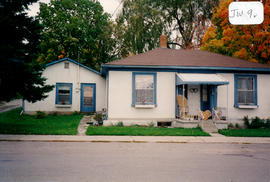29 Barrie Street Something For You and Nimbus
- CA BWGPL GJ-HB-2017-03-08-01
- Item
- 1995
Part of George Jackson fonds
Many businesses have used the flat-roofed structure located at 29 Barrie Street. It was once the home of a farm machinery business run by Reuben Tindall. When he retired, he sold the business to Dick Crake. Dick, who sold machinery and 28 Chevrolet cars, was a bachelor who did not drive. Allen Ceeiry(?) was his chauffeur. Dick had one of the first radios in town and his shop was a popular hangout for farmers and teenage boys who wanted to listen to hockey games. Dick ran the business until he retired. Then John Morden (from Kirkland Lake) started a body, fender, and paint shop at this location which he ran until his death. A businessman from Bond Head ran a blacksmith shop here for a period of time after WWII. (1, 2)
George Jackson



